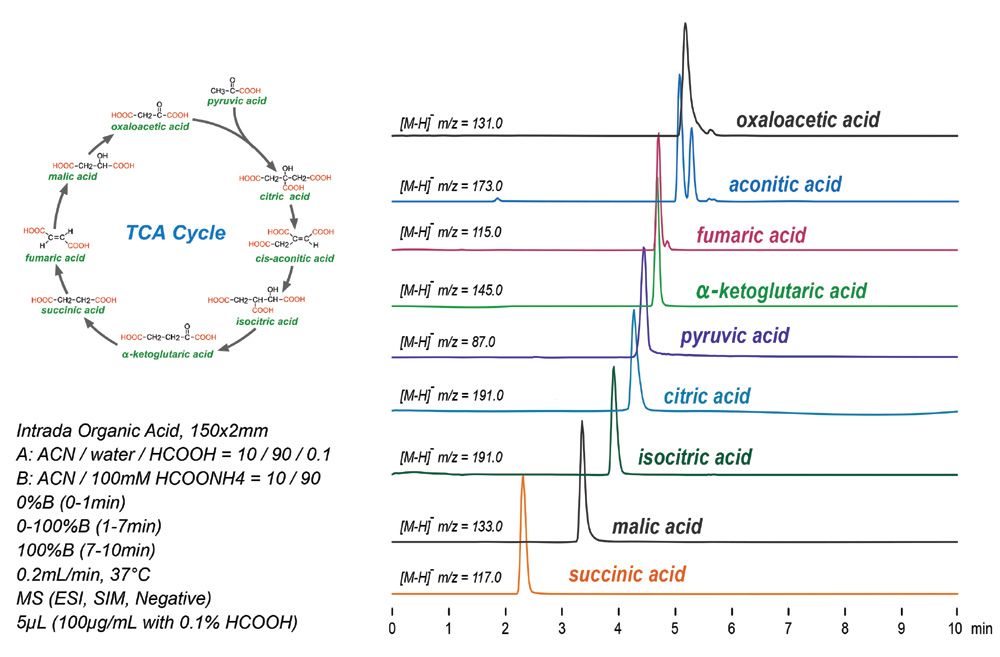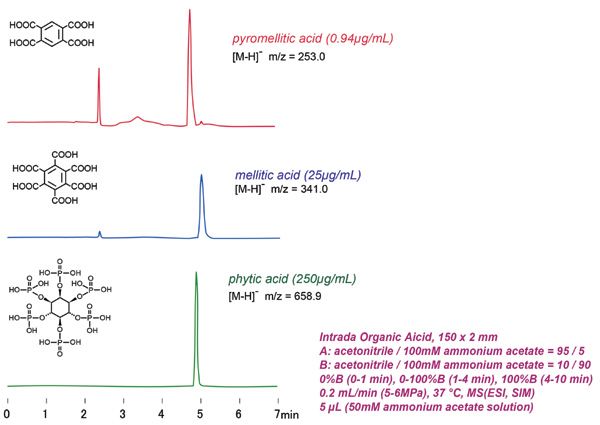Imtakt - Complete Solution for TCA Cycle Organic Acid Analysis
The TCA cycle organic acids come in a wide variety, including mono-, di-, and tri- carboxylic acids. They are notoriously difficult to analyze, especially on a single stationary phase. Our new Intrada Organic Acid column was designed not only for these compounds, but for nearly all organic acids.
TCA cycle organic acids (OA) can be important biomarkers in metabolomic studies of disease. They can be mono-, di-, or tri-carboxylic acids, which presents significant challenges to chromatographic analysis. OAs are polar, making them difficult to retain on traditional reversed phase columns without ion-pairing or derivatization. They can also contain multiple pKa values, where variations in the charge states of your analytes may cause poor peak shapes.
Recognizing these challenges, we developed them most complete solution for OA analysis, with a novel stationary phase called Intrada Organic Acid. This proprietary multi-mode column optimizes the use of multiple stationary phase structures specifically targeting OAs, delivering the most complete LC-MS-based solution on the market today.
Experimental Conditions
Running conditions are shown within the figures. MS detection was used in all cases.
Result and Discussion
Figure 1 shows simultaneous analysis of the OAs in the TCA cycle. Retention of these polar compounds was excellent with times ranging from 2.3 to 5.4 min, without using ion-pairing or derivatization. Peak shapes are nearly ideal for all analytes, but oxaloacetate does show some minor tailing. This is most likely due to the highly unstable nature of this compound, which spontaneously decarboxylates.

Figure 1: Analysis for all TCA cycle organic acids
In Figure 2, the mobile phase was optimized for OAs with multiple pKa values. For this specific challenge, we were able to achieve single sharp peaks, utilizing a combination of normal phase mode in neutral conditions and ion-exchange. We did not observe any peak splitting, shouldering, or tailing, which are common problems for polycarboxylic acids. Therefore, under certain circumstances, normal phase conditions might be preferred.

Figure 2: Improved peak shape for polycarboxylic acids
Conclusion
Organic acids comprise a staggeringly broad group, ranging from the simple carboxylic acids to complex polycarboxylic acids, where multiple acidic residues and pKA values present significant chromatographic woes. As a group, OAs can be as challenging in their analysis as the varieties that are analyzed today, but our Intrada Organic Acid can be used for wide array of OAs, on a single column. The specially developed multi-mode stationary phases utilized in this column's design provide the broadest capability for the analysis of OAs under MS-friendly conditions on the market today. We have shown that its versatility in the use of many different mobile phase conditions enables optimization to meet a wide range of needs. Never before has such a solution been available to chromatographers. Whether you are analyzing simple carboxylic acids or complex multivalent species with multiple pKa values, Intrada Organic Acid could be a single column solution for all your OA analysis needs. Please feel free to reach out to one of our column experts to learn how this revolutionary column could be used in your laboratory.

Imtakt USA
2892 NW Upshur St., Portland, OR, 97210
tel: (215) 665-8902, Toll-free: (888) 456-HPLC,
Website: ImtaktUSA.com

MALDI Guided SpatialOMx® Uncovers Proteomic Profiles in Tumor Subpopulations of Breast Cancer
September 1st 2020The timsTOF fleX system bridges a current gap by providing MALDI Imaging and in-depth proteomics analysis in just one instrument. The instrument offers all benefits of a timsTOF Pro for time-efficient and sensitive proteomics, combined with a high-resolution MALDI source and stage. Using PASEF technology, it is possible to retrieve high protein ID rates with small sample amounts. Here we present the new SpatialOMx® workflow to identify distinct proteomic profiles for different tumor subpopulations in breast cancer as an example for this powerful approach.